The Elder Scrolls IV: Oblivion
Oblivion is the most graphically intensive game we have for testing the cards in this review. It's also one of the more troublesome games to benchmark because it doesn't have any built-in demo recording/playback features and there is a large variance in performance between the different areas (outside and inside, forests and gates, etc.) of this vast game. In order to resolve this to a degree, we have two separate benchmarks we use for Oblivion: one takes place outside walking towards an Oblivion gate, and the second is in one of the towns (Bruma) walking past several characters in a snowy daylight environment.
Because Oblivion has so much eye candy, having the graphics settings on higher quality (with settings like "distant lands" turned on, and item/actor distances set for longer distances, etc.) can result in a massive performance hit in even high-end graphics cards. Since we are dealing with mid-range and low-end cards in this review, we had to turn many of the quality settings down quite a bit in order to get playable results (and even then some of the cards fall short in the Gate benchmark). Here are the graphical settings we used for Oblivion.
The first benchmark through the town is less demanding on graphics hardware than the second one with an Oblivion gate. With the "distant lands" setting to off as well as the "view distance" set to 50%, the world seems strangely limited, especially for those who have experienced the game with extended view distances. The game is still technically playable at these settings however.
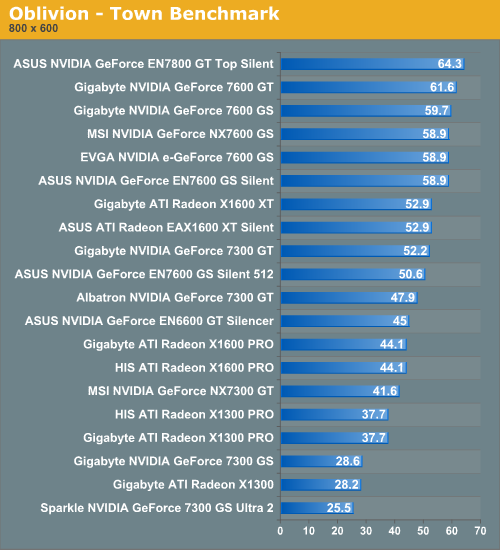
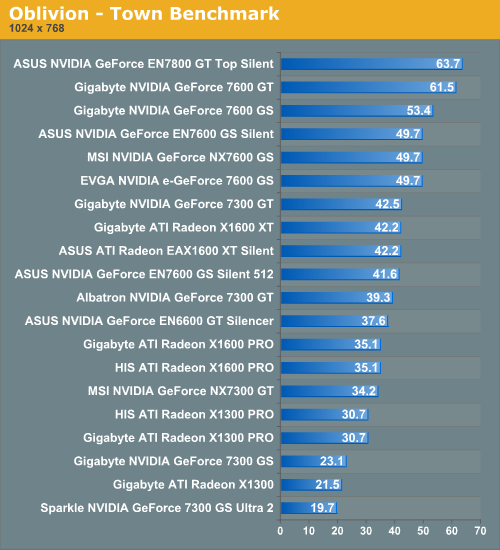
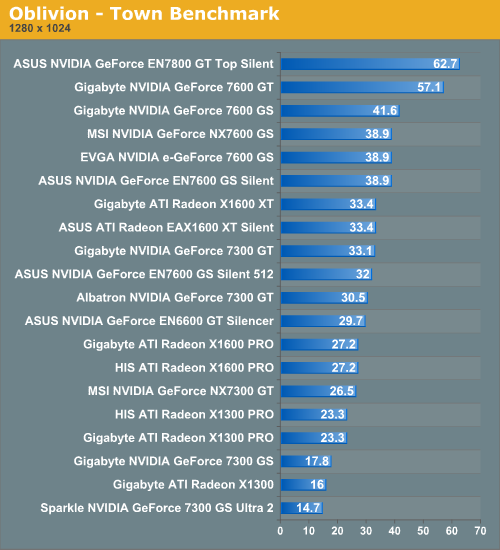
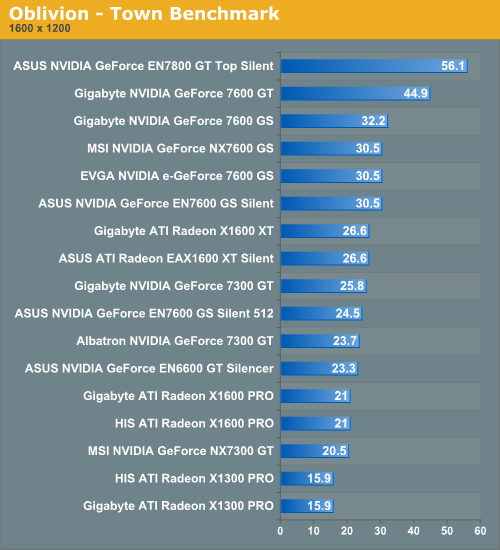
The framerates above show that these cards run this benchmark fairly well, with many cards handling 1600x1200 aside from the obvious issues with 128 MB cards (the Sparkle 7300 GS Ultra 2, Gigabyte 7300 GS, and Gigabyte X1300) and all the ATI cards except the X1600 XT. Not much is going on in this benchmark, however, aside from a few townsfolk walking around and snow falling between the buildings.
For those that have played the game, an Oblivion gate is an impressive visual spectacle to behold, very reminiscent of the "Eye" effect for Sauron in Peter Jackson's epic Lord of the Rings movies. The fact that the second benchmark takes place at night with monsters hurling fireballs at the player makes the effect even more striking, but it also tends to slow the framerate down to a crawl at even the lowest resolutions.
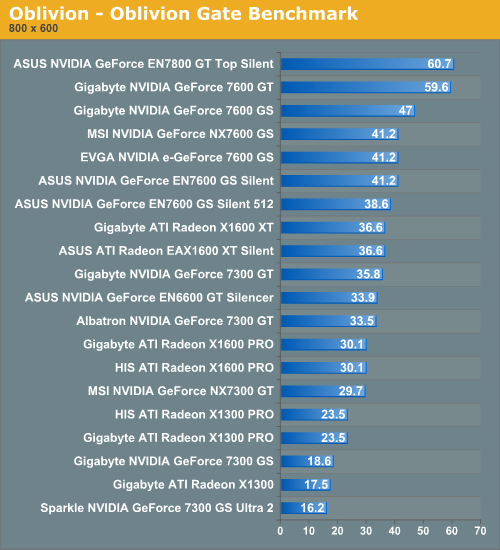
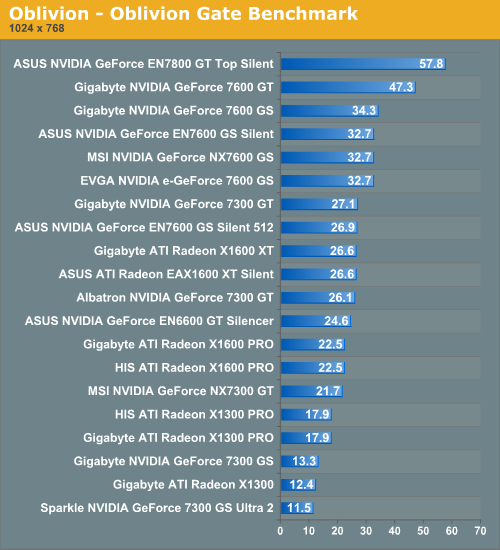
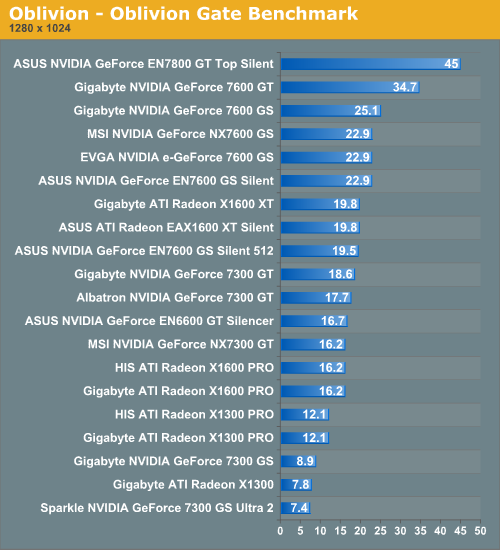
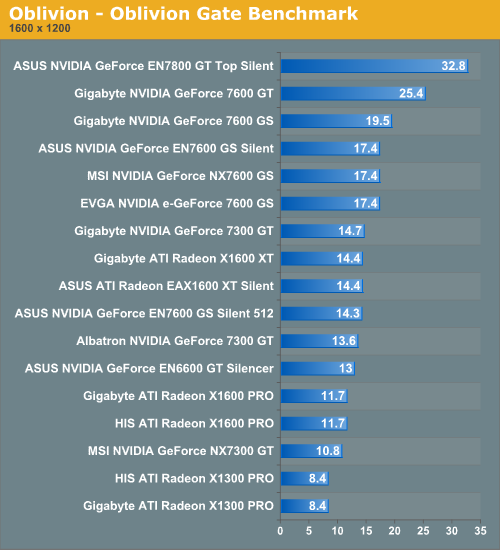
This is one of the only benchmarks we have that could bring the ASUS EN7800 GT Top Silent down to its knees at the highest resolution. Even at the lower resolution of 1024x768 most of these cards see barely playable average framerates. Because this can be a relatively fast-paced game at times, you really don't want to have to deal with framerate issues while battling some of the creatures and characters in this game. Most of the cards run smoothly at 800x600 with this benchmark, but the game isn't very enjoyable at such a low resolution.
This is all with drastically reduced image quality settings already - none of these cards can handle cranking up the eye candy in Oblivion. Unfortunately, this is one of the games that we would recommend not playing with any of these cards, with the exception of the ASUS EN7800 GT Top Silent and perhaps the Gigabyte 7600 GT. We feel a higher-end card is really needed to properly appreciate this game, though opinions vary. It is possible to play the game and even enjoy it with the settings turned way down and at the lowest resolutions, but a great deal of graphical elements are lost, and this is one of those games that relies heavily on graphics to be fully enjoyed.
Oblivion is the most graphically intensive game we have for testing the cards in this review. It's also one of the more troublesome games to benchmark because it doesn't have any built-in demo recording/playback features and there is a large variance in performance between the different areas (outside and inside, forests and gates, etc.) of this vast game. In order to resolve this to a degree, we have two separate benchmarks we use for Oblivion: one takes place outside walking towards an Oblivion gate, and the second is in one of the towns (Bruma) walking past several characters in a snowy daylight environment.
Because Oblivion has so much eye candy, having the graphics settings on higher quality (with settings like "distant lands" turned on, and item/actor distances set for longer distances, etc.) can result in a massive performance hit in even high-end graphics cards. Since we are dealing with mid-range and low-end cards in this review, we had to turn many of the quality settings down quite a bit in order to get playable results (and even then some of the cards fall short in the Gate benchmark). Here are the graphical settings we used for Oblivion.
| Oblivion Performance Settings | |
| Texture Size | Medium |
| Tree Fade | 20% |
| Actor Fade | 20% |
| Item Fade | 20% |
| Object Fade | 20% |
| Grass Distance | 0% |
| View Distance | 50% |
| Distant Land | Off |
| Distant Buildings | On |
| Distant Trees | On |
| Interior Shadows | 0% |
| Exterior Shadows | 0% |
| Self Shadows | Off |
| Shadows on Grass | Off |
| Tree Canopy Shadows | Off |
| Shadow Filtering | Off |
| Specular Distance | 20% |
| HDR Lighting | On |
| Bloom Lighting | Off |
| Water Detail | Normal |
| Water Reflections | On |
| Water Ripples | On |
| Window Reflections | On |
| Blood Decals | Off |
| Anti-aliasing | Off |
The first benchmark through the town is less demanding on graphics hardware than the second one with an Oblivion gate. With the "distant lands" setting to off as well as the "view distance" set to 50%, the world seems strangely limited, especially for those who have experienced the game with extended view distances. The game is still technically playable at these settings however.




The framerates above show that these cards run this benchmark fairly well, with many cards handling 1600x1200 aside from the obvious issues with 128 MB cards (the Sparkle 7300 GS Ultra 2, Gigabyte 7300 GS, and Gigabyte X1300) and all the ATI cards except the X1600 XT. Not much is going on in this benchmark, however, aside from a few townsfolk walking around and snow falling between the buildings.
For those that have played the game, an Oblivion gate is an impressive visual spectacle to behold, very reminiscent of the "Eye" effect for Sauron in Peter Jackson's epic Lord of the Rings movies. The fact that the second benchmark takes place at night with monsters hurling fireballs at the player makes the effect even more striking, but it also tends to slow the framerate down to a crawl at even the lowest resolutions.




This is one of the only benchmarks we have that could bring the ASUS EN7800 GT Top Silent down to its knees at the highest resolution. Even at the lower resolution of 1024x768 most of these cards see barely playable average framerates. Because this can be a relatively fast-paced game at times, you really don't want to have to deal with framerate issues while battling some of the creatures and characters in this game. Most of the cards run smoothly at 800x600 with this benchmark, but the game isn't very enjoyable at such a low resolution.
This is all with drastically reduced image quality settings already - none of these cards can handle cranking up the eye candy in Oblivion. Unfortunately, this is one of the games that we would recommend not playing with any of these cards, with the exception of the ASUS EN7800 GT Top Silent and perhaps the Gigabyte 7600 GT. We feel a higher-end card is really needed to properly appreciate this game, though opinions vary. It is possible to play the game and even enjoy it with the settings turned way down and at the lowest resolutions, but a great deal of graphical elements are lost, and this is one of those games that relies heavily on graphics to be fully enjoyed.










49 Comments
View All Comments
Josh Venning - Thursday, August 31, 2006 - link
I also forgot to mention that some people use their pcs in home theater systems as well. This would be another case when you want as little noise from your computer as possible.imaheadcase - Thursday, August 31, 2006 - link
That was not always the case, my 9700 Pro i still use when fan went out a year ago, works like a charm without it on. It was in its time the high end card, lets hope those days come buy again :Deckre - Thursday, August 31, 2006 - link
What a great review, when tom did their silent VC review, they included a grand total of three cards...pfft. nice job anand.I have the 7600GT, very sweet and 0dB is oh so nice.
Josh Venning - Thursday, August 31, 2006 - link
We just wanted to say thanks all for your comments and we are still trying to make sure we've caught any errors. (there are actually only 20 cards in the roundup and not 21) As Derek said, these cards were included in the article because we requested any and all silent cards that any of the manufacturers were willing to give us to review. That's also why we have more cards from ASUS and Gigabyte than the others.Olaf van der Spek - Thursday, August 31, 2006 - link
Because the videocard industry hasn't introduced such a bad design as the netburst architecture.
epsilonparadox - Thursday, August 31, 2006 - link
No they've introduced worse. When they recommend a second PS just for grafx or even a 1Kw single PS, they've taken intel's lack of thermal control to a whole new level.DerekWilson - Thursday, August 31, 2006 - link
graphics cards use much much less power in 2d mode than in 3d mode -- and even their 3d power saving capabilities are really good.this is especially true when you consider the ammount of processing power a GPU delivers compared to a CPU.
Theoretical peak performance of a current desktop CPU is in the 10-15 GFLOPS range at best. For a GPU, theoretical peak performance is at least one order of magnitude larger reaching up over 200 GFLOPS in high end cases.
I'm not saying we can reach these theoretical peak rates on either a CPU or a GPU, but a GPU is doing much much more work under load than a CPU possibly could.
Keep in mind we aren't even up to GHz on GPU cores. On the CPU front, Intel just shortened the pipeline and decreased clock speeds to save power -- doing more work in one cycle. This is absolutely what a GPU does.
And the icing on the cake is the sheer options on the silent GPU front. Neither AMD nor Intel make a fast desktop CPU that can be (easily) passively cooled. These parts are a testiment to the efficiency of the GPU.
On the flip side, ATI and NVIDIA push their high end parts way up in clock speed and power consumption trying as hard as possible to gain the performance crown.
There are plenty of reasons GPUs draw more power than a CPU under load, but a lack of thermal control or inefficient desing is not one of them. It's about die size, transistor count, and total ammount of work being done.
JarredWalton - Saturday, September 2, 2006 - link
I disagree with Derek, at least in some regards. The budget and midrange GPUs generally do a good job at throttling down power requirements in 2D mode. The high-end parts fail miserably in my experience. Sure, they consume a lot less power than they do in 3D mode, but all you have to do is look at the difference between using a Radeon Mobility X1400 and a GeForce Go 7800 in the Dell laptops to http://www.anandtech.com/mobile/showdoc.aspx?i=276...">see the difference in battery life.In 2D mode, graphics chips still consume a ton of power relatively speaking -- probably a lot of that going to the memory as well. A lot of this can be blamed on transistor counts and die size, but I certainly think that NVIDIA and ATI could reduce power more. The problem right now is that power use is a secondary consideration, and ATI and NVIDIA both need to have a paradigm shift similar to what Intel had with the Pentium M. If they could put a lot of resources into designing a fast but much less power-hungry GPU, I'm sure they could cut power draw quite a bit in both idle and load situations.
That's really the crux of the problem though: resources. Neither company has anywhere near the resources that AMD has, let alone the resources that Intel has. Process technology is at least a year behind Intel if not more, chip layouts are mostly computer generated as opposed to being tweaked manually (I think), and none of the companies have really started at square one trying to create a power efficient design; that always seems to be tacked on after-the-fact.
GPUs definitely do a lot of work, although GFLOPS is a terrible measure performance. The highly parallel nature of 3D rendering does allow you to scale performance very easily, but power requirements also scale almost linearly with performance when using the same architecture. It would be nice to see some balance between performance scaling and power requirements... I am gravely concerned about what Windows Vista is going to do for battery life on laptops, at least if you enable the Aero Glass interface. Faster switching to low-power states (for both memory and GPU) ought to be high on the list for next-generation GPUs.
DaveLessnau - Thursday, August 31, 2006 - link
I'm wondering why Anandtech tested Asus' EN7800 GT card instead of their EN7600 GT. That card would be more in line with Gigabyte's 7600 GT version and, I believe, is more available than the 7800 version. In the near future, I'd like to buy one of these silent 7600GTs and was hoping this review would help. Oh, well.DerekWilson - Thursday, August 31, 2006 - link
you can get a really good idea of how it would perform by looking at Gigabyte's card.as I mentioned elsewhere in the comments, we requested all the silent cards manufacturers could provide. if we don't have it, it is likely because they were unable to get us the card in time for inclusion in this review.